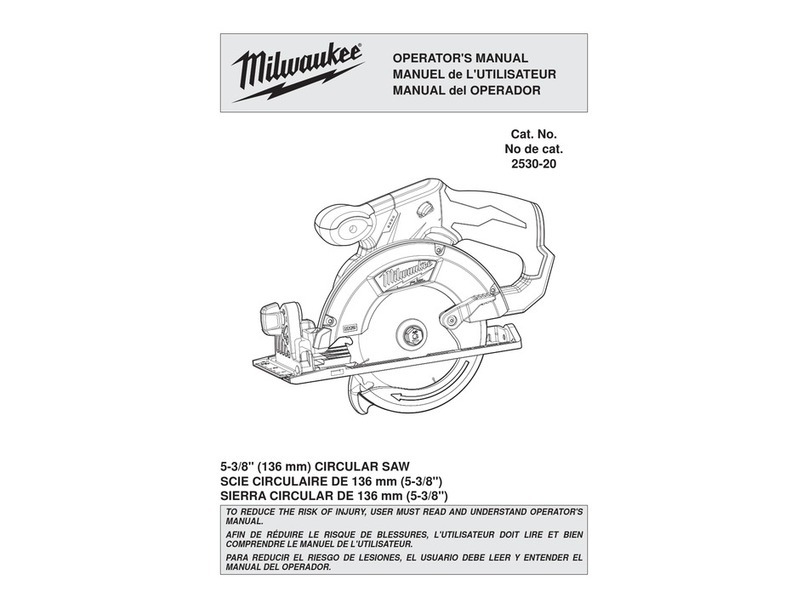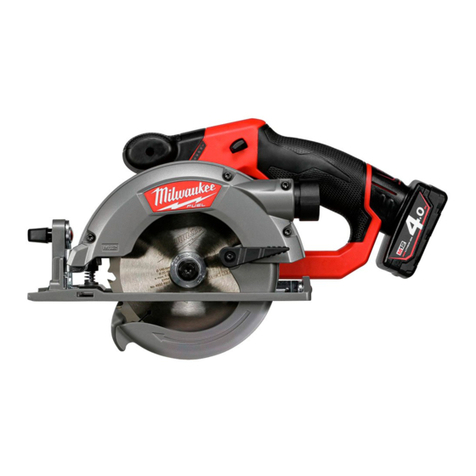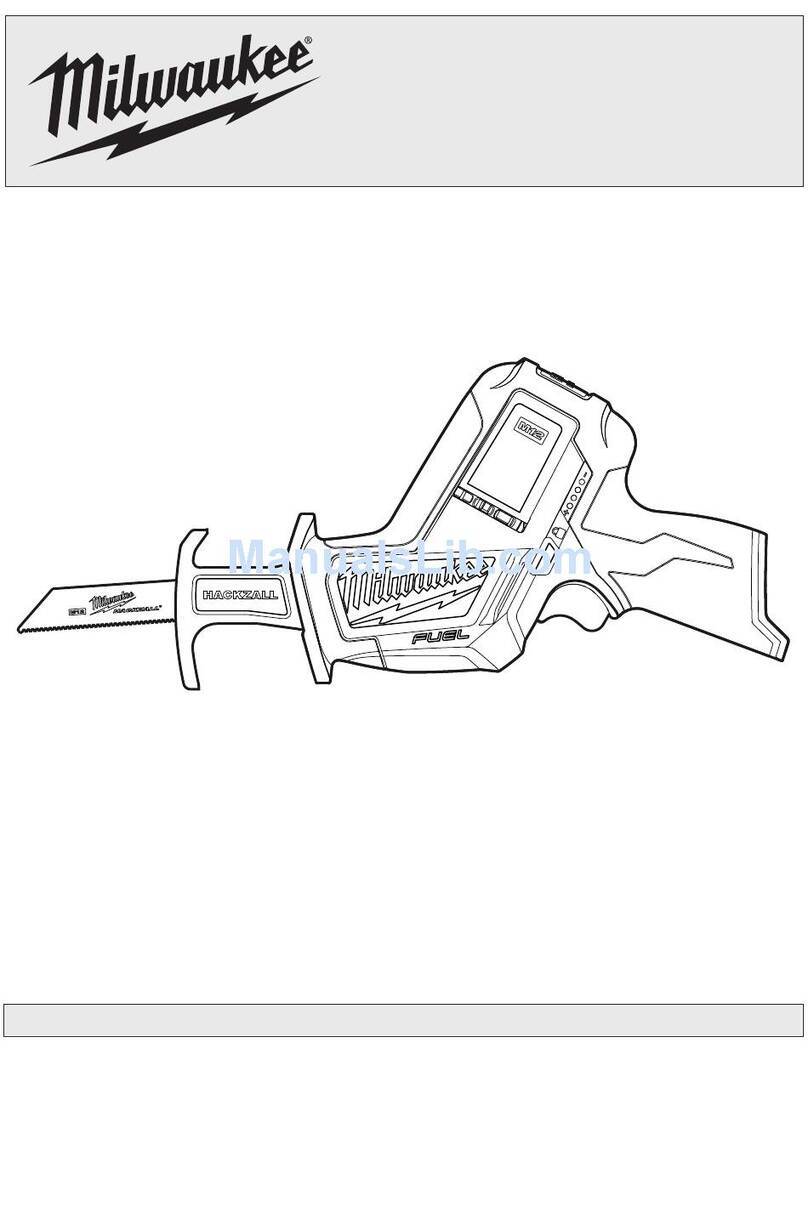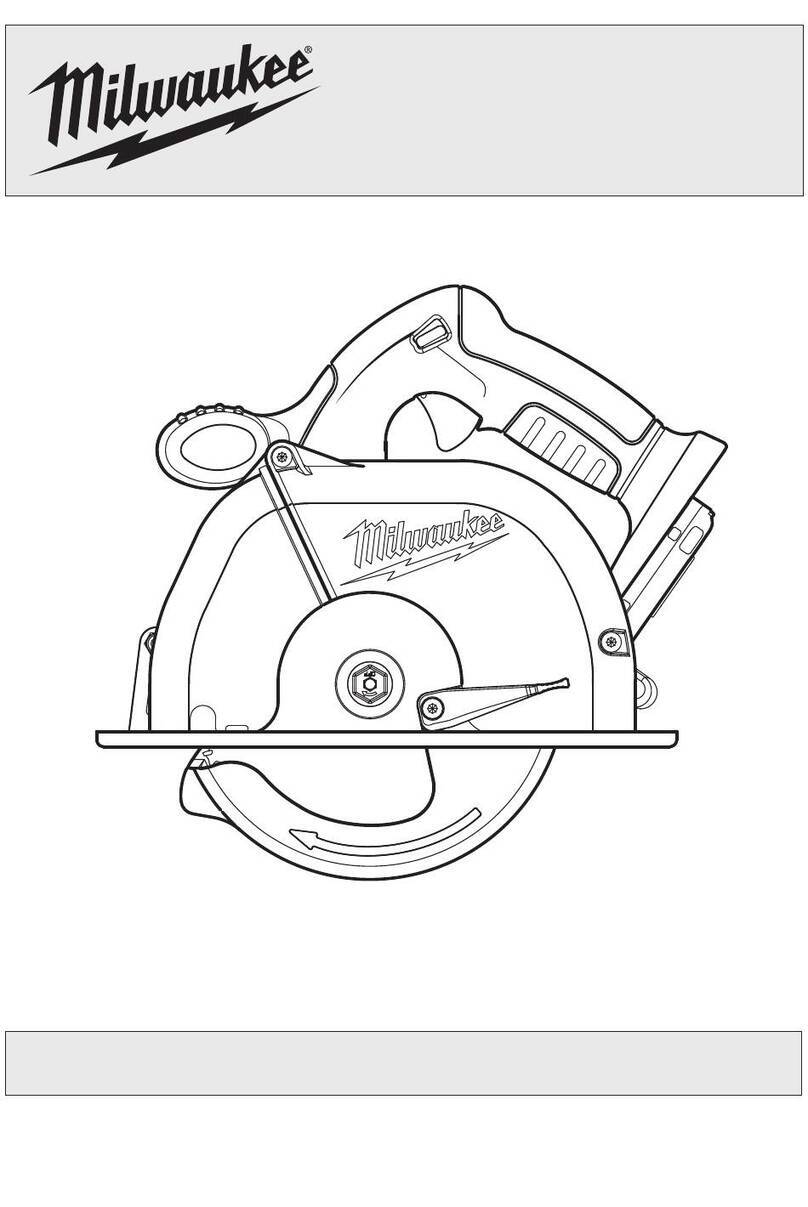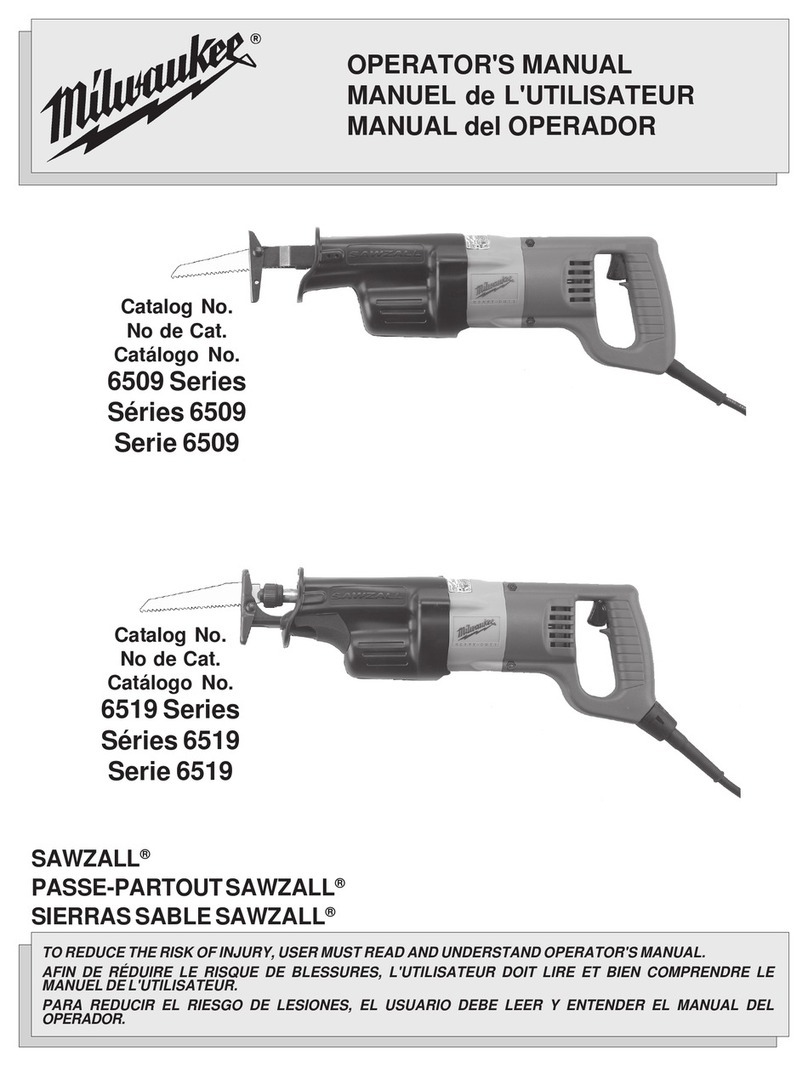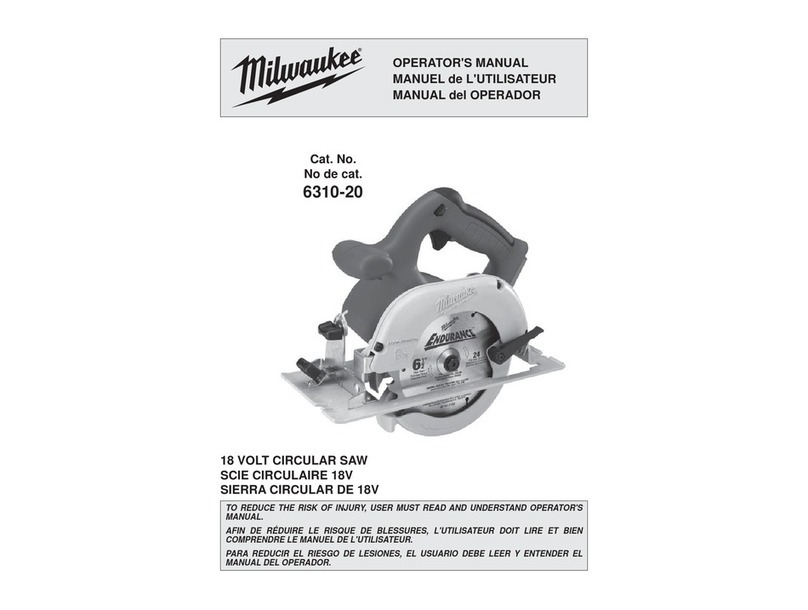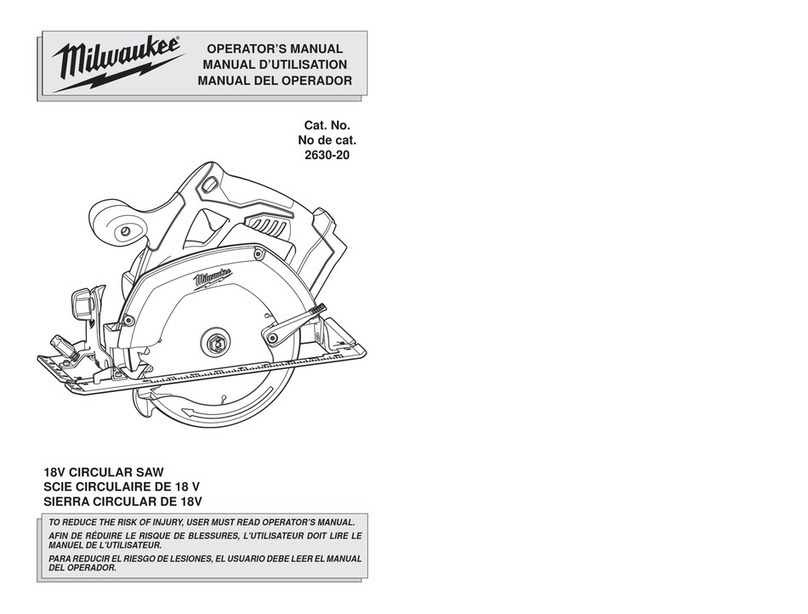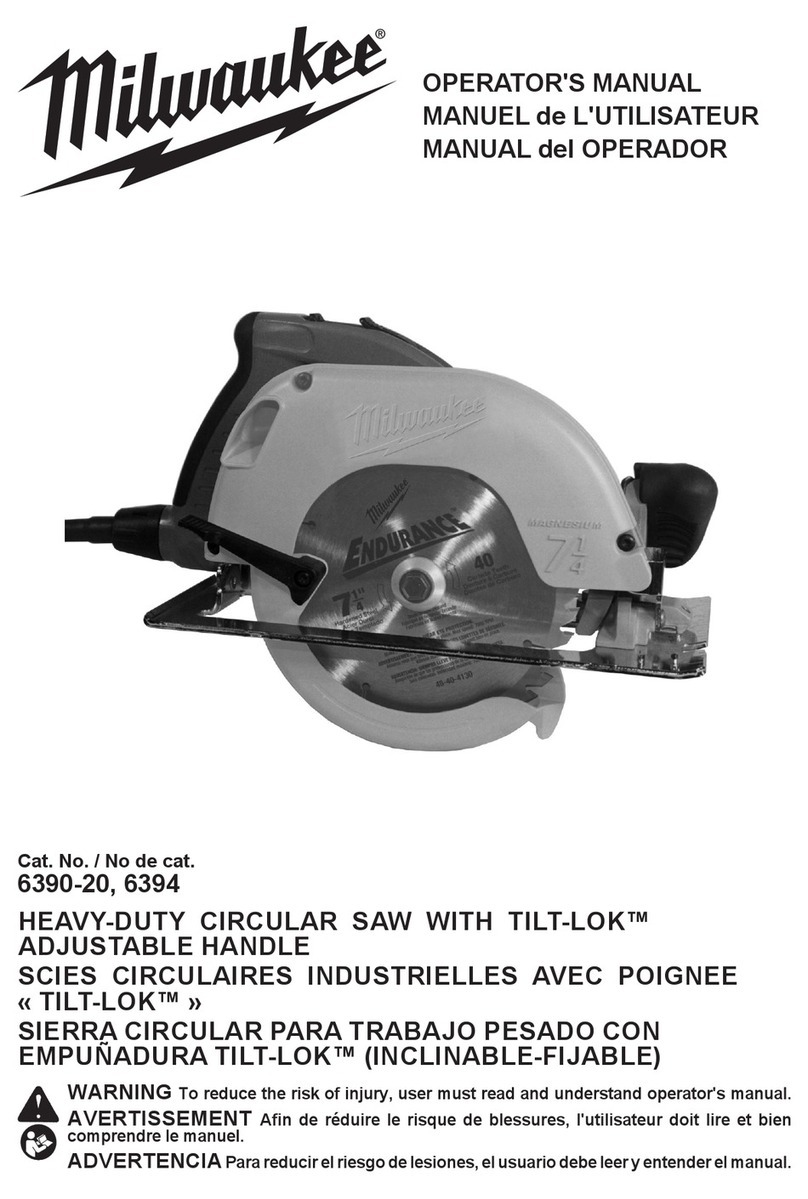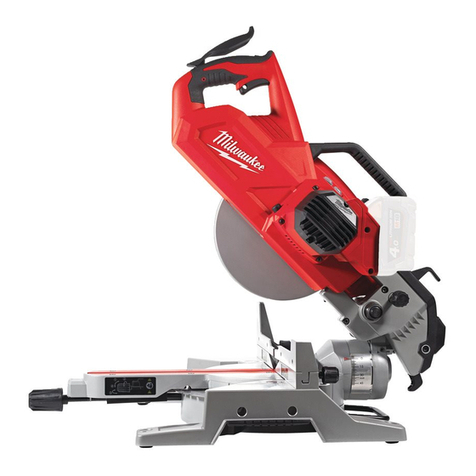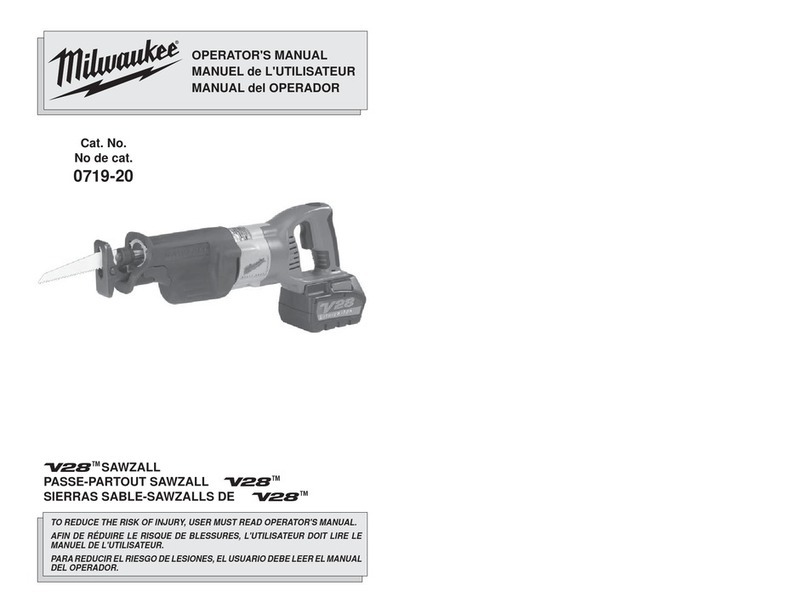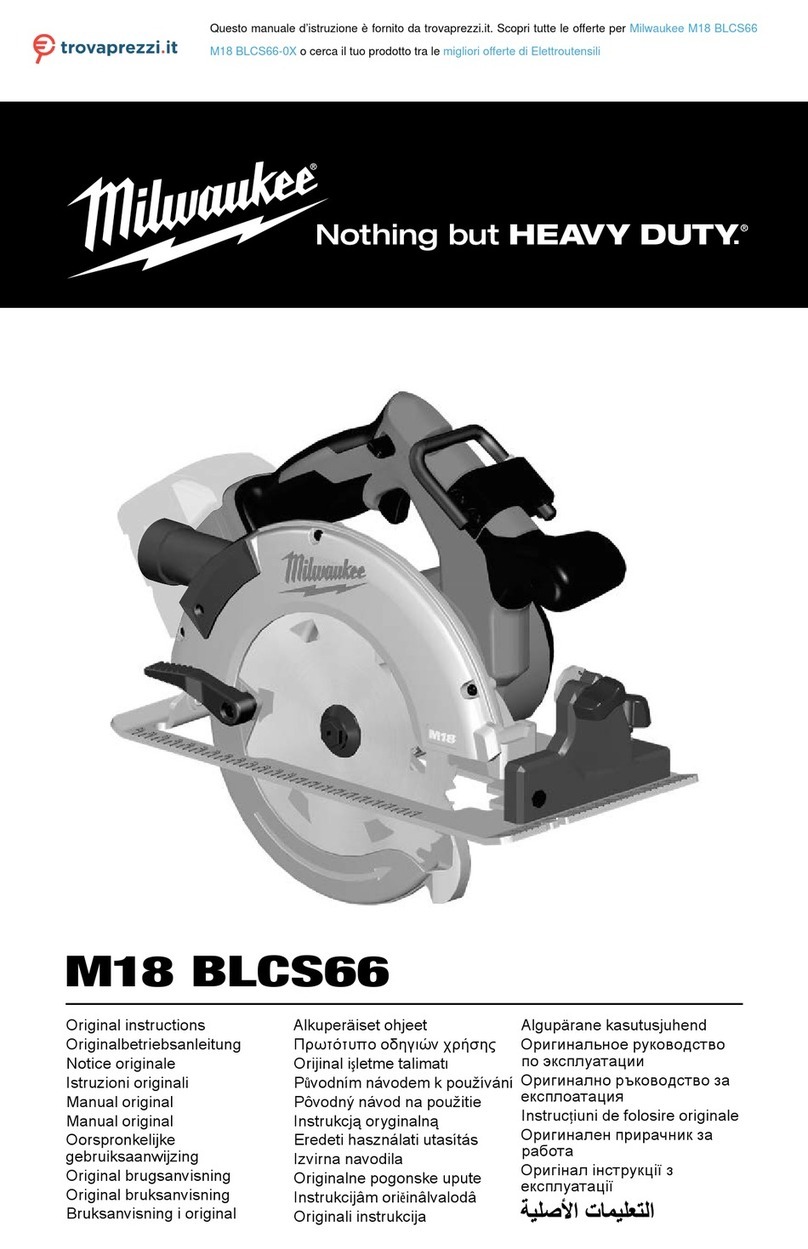12 13
RÈGLES DE SÉCURITÉ
SPÉCIFIQUES
ENTRETIEN
page des pièces mobiles, de toute rupture de
pièce ou de toute autre condition qui pour-
rait affecter le bon fonctionnement de l’outil
électrique. En cas de dommages, faire réparer
l’outil avant de l’utiliser de nouveau. Les outils
électriques mal entretenus sont à la source de
nombreux accidents.
•Garder les outils de coupe affûtés et propres.
Les outils de coupe correctement entretenus et
bien affûtés risquent moins de se gripper et sont
plus faciles à manier.
•Utiliser l’outil électrique, les accessoires, les
grains etc. conformément à ces instructions
en tenant compte des conditions de travail
et de la tâche à effectuer. L’utilisation de cet
outil électrique pour effectuer une opération pour
laquelle il n’est pas conçu peut occasionner une
situation dangereuse.
•Faire effectuer l’entretien de l’outil électrique
par un technicien qualifié qui n’utilisera que
des pièces de rechange identiques. Lasécurité
d’utilisation de l’outil en sera préservée.
Règles de sécurité générales pour le découp-
age à l’abrasif :
•Cet outil électrique est conçu pour servir de
d’outil de coupe. Lire tous les avertissements
et toutes les instructions, les illustrations et
les caractéristiques fournis avec cet outil élec-
trique. Ne pas suivre l’ensemble des instructions
décrites ci-dessous peut entraîner une électrocu-
tion, un incendie ou des blessures graves.
•Il n’est pas recommandé d’utiliser cet outil
électrique pour servir de meuleuse, de pon-
ceuse, de brosse métallique ou polissage. Le
fait d’utiliser l’outil pour effectuer des tâches pour
lesquelles il n’est pas conçu peut présenter un
risque et entraîner des blessures.
•Ne pas utiliser des accessoires qui ne sont pas
spécialement conçus pour le modèle d’outil ou
qui ne sont pas recommandés par le fabricant.
Le simple fait qu’un accessoire peut s’ajuster sur
l’outilélectrique ne signifie pas qu’ilpeutêtreutilisé
en toute sécurité.
•La vitesse nominale de l’accessoire doit au
moins être égale à la vitesse maximale indi-
quée sur l’outil électrique. Les accessoires qui
sontutilisés à une vitesse supérieure à leur vitesse
nominale peuvent se briser et se détacher.
•Le diamètre extérieur et l’épaisseur de
l’accessoire doivent être conformes à la ca-
pacité de l’outil électrique. Il est impossible de
protégerou de contrôler adéquatement un acces-
soire de dimension inappropriée.
•La taille de l’arbre des meules, des brides, des
plateaux porte-disque ou de tout autre acces-
soire doit convenir parfaitement à la broche
de l’outil électrique. Si les accessoires utilisés
sont dotés d’alésages centraux qui ne convien-
nent pas à la pièce de montage de l’outil, ils se
déstabiliseront, vibreront de façon excessive et
pourront causer une perte de contrôle.
•Ne pas utiliser un accessoire endommagé.
Inspecter l’accessoire avant chaque utilisation
afin de s’assurer que les meules, par exemple,
sontexemptes d’ébréchures et de fissures,que
le plateau porte-disque est exempt de fissures
et qu’il n’est pasusé de façon excessive, etque
la brosse métallique ne comprend pas de fils
détachés ou craquelés. Si l’outil électrique ou
l’accessoire est échappé, s’assurer qu’il n’est
pas endommagé ou installer un autre acces-
soire. Après avoir effectué cette opération, se
tenir à distance de l’accessoire en rotation
et faire fonctionner l’outil à sa vitesse à vide
maximale pendant une minute. S’assurer que
personne ne se tient à proximité de l’outil. Les
accessoires endommagés se brisent générale-
ment lors de cette vérification.
•Porter de l’équipement de protection de qualité
professionnelle. Selon le type d’opération, por-
ter un masque de protection ou des lunettes
de sécurité. Au besoin, porter également
un masque anti-poussières, un protecteur
d’oreille, des gants et un tablier d’atelier ré-
sistant aux petits fragments abrasifs ou aux
fragments provenant des pièces à travailler.
La protection oculaire utilisée doit résister aux
débris projetés lors des différentes opérations.
Le masque anti-poussières et le masque filtrant
doivent filtrer les particules produites lors de
l’opération. Une exposition prolongée à un bruit
fort peut entraîner une perte auditive.
•S’assurer que personne ne se tient à proximité
du lieu de travail. Toute personne qui entre
sur le lieu de travail doit porter l’équipement
de protection requis. Des fragments provenant
de la pièce à travailler ou d’un accessoire brisé
peuvent être projetés et causer des blessures,
même à des personnes se tenant à une certaine
distance du lieu de travail immédiat.
•Tenir l’outil par ses surfaces de préhension
isolées lors des opérations pendant lesquelles
l’accessoire de coupe peut entrer en contact
avec du câblage caché ou avec son propre
cordon d’alimentation. Le contact avec un fil
sous tension « électrifie » les pièces métalliques
exposéesdel’outiletpeut électrocuter l’utilisateur.
•Tenir le cordon loin de l’accessoire en rota-
tion. En cas de perte de contrôle, le cordon peut
être coupé ou accroché, et la main ou le bras
de l’utilisateur risquent d’entrer en contact avec
l’accessoire en rotation.
•Ne jamais déposer l’outil électrique avant
l’arrêt complet de l’accessoire. L’accessoire en
rotation peut accrocher la surface et occasionner
une perte de contrôle.
•Ne jamais laisser l’outil électrique fonctionner
en le transportant à ses côtés. L’accessoire en
rotation peut s’accrocher accidentellement aux
vêtements et entrer en contact avec l’utilisateur.
•Nettoyer régulièrement les évents d’aération
de l’outil électrique. Le ventilateur du moteur
aspire la poussière dans le logement et crée une
accumulationexcessivedemétalfritté, ce qui peut
causer un risque électrique.
•Ne pas faire fonctionner l’outil électrique à
proximité de matériaux inflammables. Les
étincelles peuvent enflammer ces matériaux.
•Ne pas utiliser d’accessoires qui nécessitent
des liquide de refroidissement. L’utilisation
d’eauoud’unautreliquidederefroidissementpeut
entraîner une électrocution ou un choc électrique.
REBONDS ET AVERTISSE-MENTS CONNEXES
-Un rebond est une réaction soudaine attribuable
au pincement ou à l’accrochage de la meule, du
plateau porte-disque, de la brosse ou de tout
autre accessoire en rotation. Un pincement ou
un accrochage provoque le blocage immédiat de
l’accessoire en rotation qui, à son tour, entraîne
l’outil incontrôlé dans le sens opposé à la rotation
de l’accessoire, à l’endroit du coincement.
Parexemple, si une meule abrasive est accrochée
ou pincée par la pièce à travailler, le rebord de la
meule qui entre dans le point de pincement peut
s’enfoncerdanslasurfacedu matériau, éjectant la
meuledelapièceàtravailleroulafaisantrebondir,
vers l’utilisateur ou loin de lui, selon le sens du
mouvement de la meule au point de pincement.
Danscesconditions d’utilisation, les meules abra-
sives peuvent également se briser.
-Un rebond est attribuable à une mauvaise utilisa-
tiondel’outilouaunon-respectdesprocéduresou
desconditions d’utilisation. Pour empêcher les re-
bonds,respecter les directives décrites ci dessous.
•Tenir fermement l’outil électrique et placer le
corps et lesmains de manièreà pouvoirrésister
auxrebonds. Toujours utiliser la poignéeauxili-
aire, s’il y en a une, pour assurer un contrôle
optimal en cas de rebond ou de réaction de
couple lors du démarrage de l’outil. L’utilisateur
peut contrôler les rebonds et les réactions de
couple s’il respecte les directives prescrites.
•Ne jamais placer les mains à proximité de
l’accessoire en rotation. En cas de rebond,
l’accessoire peut dévier sur celles ci.
•Ne pas positionner le corps à l’endroit où
sera entraîné l’outil électrique si un rebond se
produit. Un rebond entraînera l’outil dans le sens
opposé au mouvement de la meule, à l’endroit de
l’accrochage.
•Faire preuve d’une extrême prudence au mo-
ment d’utiliser l’outil sur des coins ou des
rebords tranchants. Les coins, les rebords
tranchants et les surfaces rebondissantes ont
tendance à s’accrocher à la pièce en rotation et à
causer une perte de contrôle ou des rebonds.
•Ne pas fixer une lame de sculpteur pour scie à
chaîne ou une lame de scie dentée. Ces deux
typesdelame occasionnent de nombreux rebonds
et des pertes de contrôle fréquentes.
Règles de sécurité particulières pour tronçon-
nage à la meule :
•Utiliser seulement les types de meule recom-
mandés pour cet outil électrique et le protège
disque spécialement conçu pour la meule
utilisée. Il est impossible de protéger de façon
adéquatelesmeulesqui ne sont pas spécialement
conçues pour l’outil électrique. De plus, elles ne
sont pas sécuritaires.
•Le protège disque doit être fixé solidement
à l’outil électrique et positionné de manière
à garantir une sécurité optimale; il importe
donc de diriger le moins possible la meule vers
l’utilisateur. Le protège disque aide à protéger
l’utilisateurdesfragmentsquipeuventse détacher
dela meule et du contact accidentel avec la meule.
•Utiliser seulement les meules pour effectuer
des opérations pour lesquelles elles sont con-
çues. Par exemple, ne pas meuler avec le côté
d’unemeule à tronçonner.Lesmeulesàtronçon-
ner abrasives doivent être utilisées pour la rectifi-
cation périphérique. Le fait d’appliquer une force
latérale sur les meules peut provoquer leur bris.
•Toujours utiliser des brides de meules non en-
dommagées de formes et de dimensions con-
venables.Lesbridesdemeulesadéquatessoutien-
nent la meule, ce qui minimise les risques de bris
de la meule. Les brides des meules à tronçonner
peuvent différer des brides de meules standards.
•Ne pas utiliser de meules usées qui provien-
nent d’outils électriques de plus grandes
dimensions. Lesmeules conçues pour des outils
électriques de plus grandes dimensions ne con-
viennentpas à la vitesseplus élevée des outils de
plus petite dimension et peuvent éclater.
Règles de sécurité particulières pour Tronçon-
nage à la meule :
•S’assurer que la meule à tronçonner ne se
coince pas et éviter d’appliquer trop de pres-
sion. Ne pas régler la meule à une profondeur
de coupe excessive. Le fait d’appliquer trop de
pression sur la meule augmente la charge, la
tendance de la meule à se tordre ou à se coincer
pendant la coupe, ainsi que les risques de rebond
ou de bris de la meule.
•Ne pas se tenir vis-à-vis de la meule en rotation
ouderrière celle-ci. Pendantl’opération, lorsque la
meule s’éloigne de l’utilisateur, un rebond pouvant
projeter la meule en rotation et l’outil électrique
directement vers l’utilisateur peut se produire.
•Si la meule se coinceou si l’opération decoupe
est interrompue pour une raison quelconque,
éteindre l’outil électrique et le maintenir im-
mobile jusqu’à ce que la meule s’arrête com-
plètement. Ne jamais tenterde retirer la meuleà
tronçonner lorsque celle-ci est en mouvement
afin d’éviter qu’un rebond ne se produise.
Examiner la situation et trouver une solution qui
permettra d’éviter que la meule ne se coince.
•Ne pas remettre en marche l’outil si celui-ci est
dans la pièce à travailler. Permettre à la meule
d’atteindre sa vitesse maximale puis la réin-
sérer dans le trait de coupe avec précaution.
La meule risque de se coincer, de se soulever ou
de rebondir si cette précaution n’est pas prise.
•Soutenir les panneaux ainsi que toute pièce à
travailler surdimensionnée afin de minimiser
les risques de pincement de la meule et de
rebond. Lespiècesà travailler de grandes dimen-
sionsont tendance à fléchir sous leur propre poids.
Il importe donc de disposer des supports sous la
pièce à travailler, près du trait de coupe ainsi que
du rebord de la pièce à travailler, des deux côtés
de la meule.
•Faire preuve d’une grande prudence au mo-
ment d’effectuer une coupe de petite dimen-
sion dans un mur ou à tout autre endroit où
la visibilité est réduite. La meule sortante peut
couper les conduites d’eau ou de gaz, le câblage
électrique, ainsi que tout autre objet pouvant pro-
voquer un rebond.
Règles de sécurité supplémentaires
•Maintenir en l’état les étiquettes et les plaques
d’identification. Des informations importantes y
